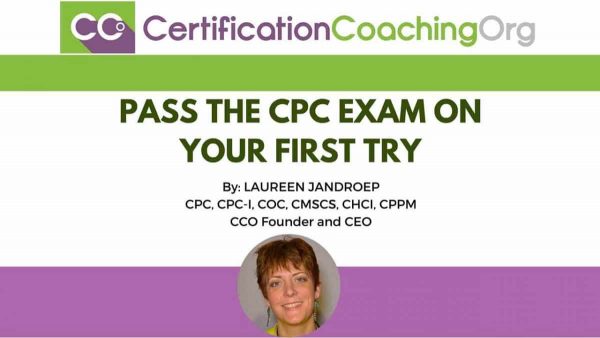
What I’m about to share with you are the very, very best tips from me on how to pass the CPC exam on your first try and I’m teaching this method since 1999. This is more of a “how to prepare for the CPC exam,” and it’s very successful. People follow my strategies, they always pass when they go to take it the next time, but it’s very key not to skip or skimp on any of the steps that I’m about to share with you.
It is going to require some more work if you want to follow my techniques, so if you’re taking the CPC board exam there will be a lot in these that will help you, but there might be some extra things you might not have time to do, like, a way to prepare your manual and practice exams. I will also show you our CPC Review Blitz that we do and what’s it all about.
Video: How To Pass the CPC Exam On Your First Try
By Laureen Jandroep, CPC, CPC-I, COC, CMSCS, CHCI, CPPM | CCO Founder and CEO

I started off as an occupational therapist and coding was just a way for me to bill six different things, PT, OT, speech, “eval”, and “reeval”, that was it, so the diagnosis side was really more of the biggie for me. So, now getting into this when I went to go get myself certified it was, wow, I had no idea all the little layers of everything. A lot of what I’m going to share with you is how I taught myself as someone who took a week-long boot camp, and then a month later took the exam. And during my boot camp I didn’t even know what an E/M was, I thought it was a new M&M candy.
If I can do it, you can do it. I want to teach you how. I’m a very visual learner myself and a lot of these techniques came from that.
Happy learning!
How to Pass the CPC Exam On Your First Try
Alright, so let’s get into the step-by-step process on how you can ace the CPC exam on your first try. I call it the “Formula for CPC Exam Success”:
Step 1. Take a Full Medical Coding Course
You want to make sure you’ve taken a Full Medical Coding Course, or you’ve had some equivalent of experience like working for a multi-surgery center, or something like that.
Step 2. Take a Review Class
Like the Review Blitz that we do. It’s a two-day review, where we cover everything that you would encounter on the CPC board exam.
Step 3. Use the BHAT® Method to Mark Up Your Book
I’m going to teach you that technique today. It’s not a hard technique but it’s something that we’ve trademarked and we’ve taught since 1999, and it does take time to do, but it is well worth it.
It saves you a lot of time on the CPC exam, and it saves you time in real world coding, too, to help you compare and contrast codes, and to do process of elimination.
Step 4. TIMED Practice Exams
Until you score an 85%. You need a 70% to pass the real CPC board exam but an 85% is what we want you to shoot for in the practice exams to kind of give you that cushion, that buffer. I have “TIMED” capitalized because it’s very important. If you’re just doing questions to see that you understand the concept, then that’s like doing homework. That is, in a practice exam, you need to get that timing element in there to really learn that and I’ll go over that more before we’re done.
CPC Exam Layout
Before going deeper in our discussion, first let’s talk about the CPC exam layout. This is all from the AAPC website; when you click on certifications and you go to CPC it tells you it’s 100 questions. You have four hours to complete it. It’s up to you how you manage your time.
70% passing!
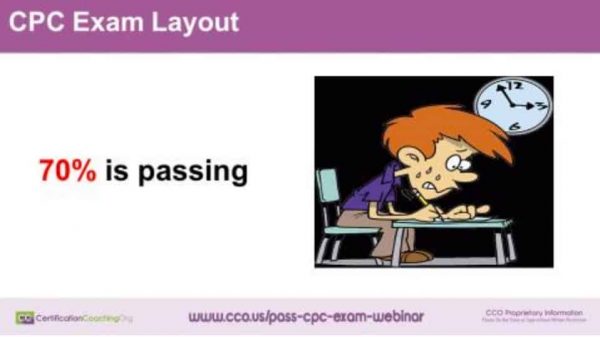
You need to get a 70% overall. Years ago they used to have us get a 70% in section one, section two, and section three, they don’t do that anymore; so really you want to get to all the easy questions, which are easy for you, so that you can get a 70% or higher. That’s really the goal.
When you break that down, you can get 30 questions wrong and still pass, that’s pretty good. So, when you’re doing your practice exams, what you’re really going to be practicing is skipping questions. You’re skipping hard ones to get to easy ones, that’s the goal because if you get where you’ve missed 30 and you’ve got all the other ones correct you could basically stop. Of course you’re not, you’re going to keep going to maximize your chances, but keep that in mind when you’re skipping. “OK, this is going to be one of my 45.” That makes it less stressful, if you will.
CPC Exam Tips
Learning how to take the CPC exam is really a lot of what we’re going to be talking about today. So here are some general CPC exam tips for you. Know that the exam is not specialty specific. You’re not going to be asked detailed vascular interventional radiology questions but you’re going to be asked broad basic questions and hence you’re not going to need to know deep, deep, deep knowledge that you would need to go for a specialty certification.
Tip #1. Focus on principles of good coding.
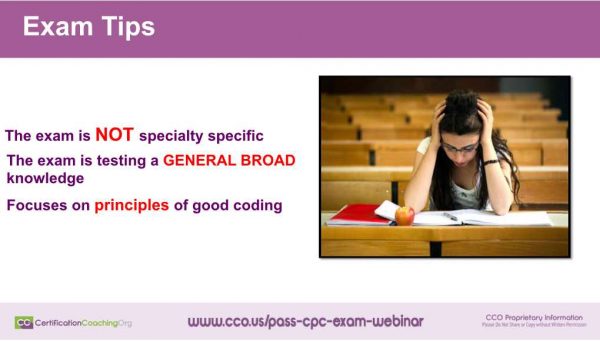
That’s really what they’re testing you on. If you could go look up a code real quickly in the index and verifying in the main part of the CPT manual you’d be done, but they’re not going to give you those easy ones. They got to give you ones with better testing your ability to read and interpret the guidelines, that’s really what it’s about.
Tip #2. Throw out your billing and reimbursement knowledge.
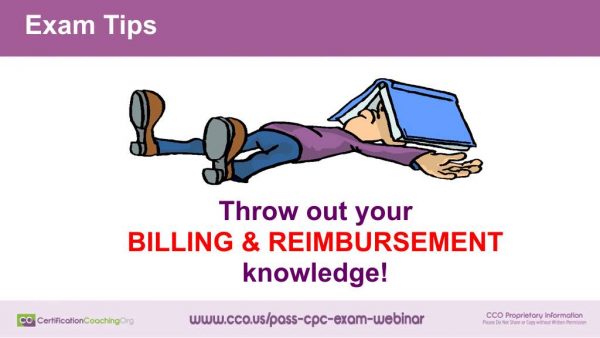
If you are currently doing coding or doing billing and reimbursement, sometimes that knowledge is going to hurt you because there’s the manual way, the guidelines, or what I like to call “the perfect coding world” – and that’s why I like to teach because I get to live in the perfect coding world – you have to temporarily throw out your billing and reimbursement knowledge. When you’re looking at a board exam question, focus on the core of the question, don’t read into it, don’t overthink it, just what is it about? So that billing and reimbursement knowledge you’ll need to throw out.
Here’s an example about how billing and reimbursement knowledge could sometimes hurt you
Remember, on the CPC exam, you’re going to code according to CPT guidelines and that’s just an example of how billing knowledge could hurt you, so really make sure you’re looking at what the guidelines are telling you, not what you know how you do it at work.
Tip #3. Confidence and time management are vital.
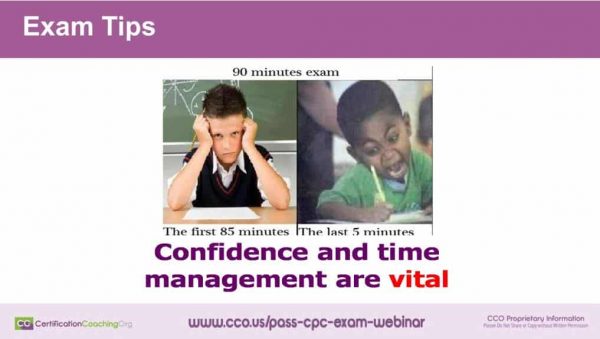
The more you do those TIMED practice exams the more your confidence is going to go way up. If you know you’ve gotten 85% on a practice exam that’s very similar in difficulty level to the real CPC exam, you can go in with confidence. You’ve got your technique down, you know how to skip questions, you know how to spend about an hour per column, and that’s going to boost your confidence. Practice that when you’re doing the practice exams. Practice how to take the exam, in addition to the content.
A lot of people if they only have a week or two prior to exam date and say, “What do I study?” I said, “Stop studying. You need to do TIMED practice exams,” and the TIMED practice exams will reveal your areas of weakness and content knowledge, but at the same time you get to practice how to take the exam, and that’s really what’s most important
Tip #4. Plan on having some unanswered questions — don’t freak out!
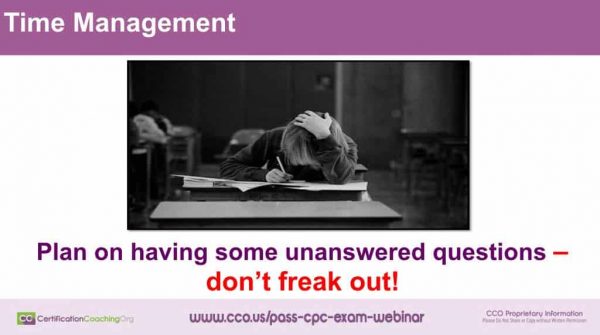
You want to plan and expect to have unanswered questions, it’s OK. You really only have about two minutes per question on the exam. That might be fine for medical terminology question but for one that has a mini op [Ed. Note: operation] report, and each answer has four codes that is a little hard to do in two minutes, so you really want to spread your success out and understand that you might have some unanswered questions.
I do recommend that you don’t leave any unanswered when you have five minutes left then you go fill in, you take a guess, if you’ve narrowed it down to two, we’ll pick one of the two, and I’m going to show you a technique for maximizing that, too.
Tip #5. Don’t over think or read into a question — Stick to your job!
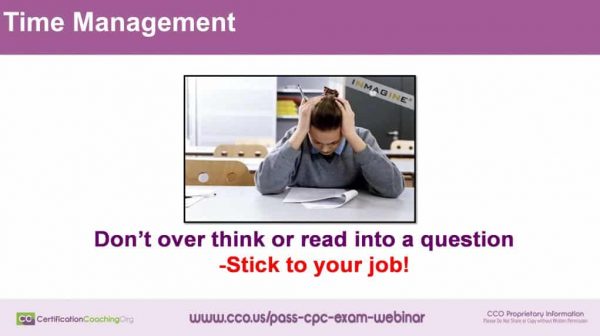
Here’s a big one, coders are notorious for this – we overthink things. We think they’re trying to trick us, or “I know. We do that. We code that at work and this is how we do it. This is the right way that I was told how to do it.” Don’t overthink it. Look at the scenario as it’s presented. If they tell you that something was done on an emergency basis and you’re looking at the code answers, and one is for emergency and one is not, you go “Umm, they’re trying to trick me because I read that scenario and it doesn’t sound like an emergency to me. They’re not going to get me.” No, you’re overthinking it. If they use that word “emergency” take their word for it and move on. Try not to overthink it.
This is we’re practicing with the timed practice exams, we’ll teach you and you’ll catch yourself overthinking things when you go to look at your score and you look at the rationales, you say “Aha, that was one I overthought.” The next time you do the practice exam, then you’ll catch yourself and you’ll prevent that habit, and you’ll start improving. Normally we find that our students take three timed practice exams to really get these techniques down pat.
Tip #6. Pick the BEST of the possible answers.
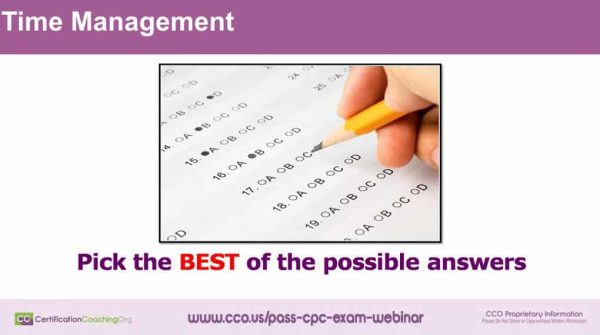
Another thing that I always tell my students from day one when I teach my 20-week course is I start prepping them, “What is your job on the board exam? To pick the best of the four possible answers; and they’ll say that every time, “To pick the best of the four possible answers”. It’s the same for the board exam for you guys. The difference when you’re taking a test for class after a chapter you have a little bit more time and sometimes you get a case to code, but on the CPC board exam, it’s not like that. You’re getting four possible answers to choose from, so you can’t read the note, go look up in the index, turn to the main part of the book and confirm it, you don’t have that kind of time. You actually need to go to the answers and compare and contrast them and show, and be able to pick out which one is the best. Process of elimination.
CPC Exam Time Management Tips
The Timing Method (One Hour Per Column Timing)
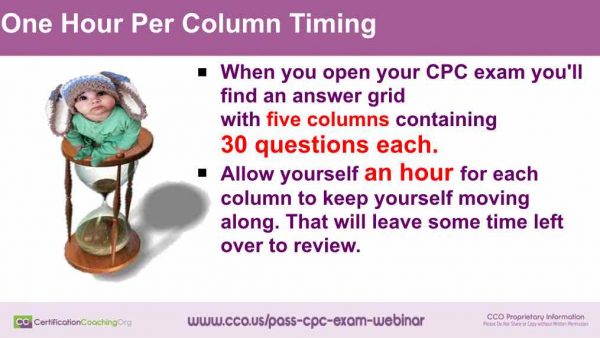
What I recommend you do if you have that answer grid in front of you, take a look at it and you’ll see questions 1 – 30 in the first column. I love how they divide this because the timing technique that we teach is give yourself one hour per column; so after 20 minutes you should be past question 10 or at question 10. At 40 minutes, you should be at question 20 and then at 60 minutes you should be finishing; so your first checkpoint is at 20 minutes, and if you’re at question 6, you know you got to step it up, you got to move the speed up. By giving yourself one hour per column, it forces you to do that, and your goal is you’re really looking for the easy ones to move on. That’s the timing method.
Learn more about this “One Hour Per Column Timing” technique here!
The Combo Method
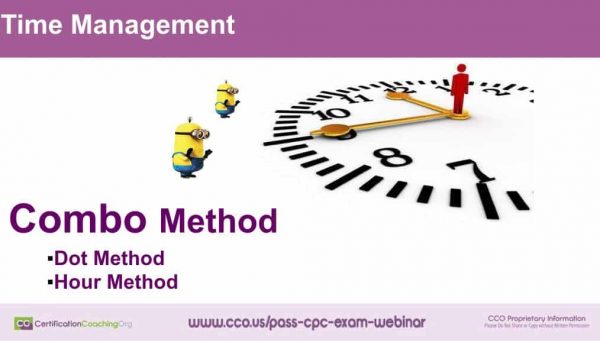
The Combo Method is combining the one hour per column and then using the dots. Years ago, I’ve been doing this since 1999, I used to just teach the dot method and when you hear the proctor instructions read they pretty much tell you to do that, like, skip through and get to the easy ones and go back. So, by doing the dots on your answer grid rather than the booklet, it’s your road map, and it makes it very clear where you need to go.
Marking Up Your Manuals (TOP TIP!!!) – Master the Process of Elimination through the BHAT® Technique
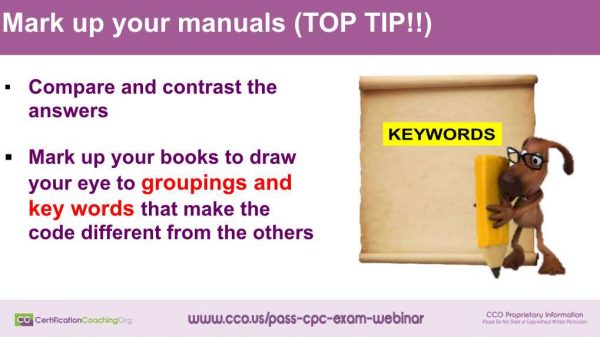
This is a technique that we teach to help you with that process of elimination. It’s called BHAT™ and basically what I did for myself when I had to go take my board exam a month later, and I’m a procrastinator, for two weeks I didn’t even study, so I had two weeks to prepare before taking this board exam. I will admit, I’m a pretty good test taker, so I sat down like an engineer, I looked at it and said, “It’s an open book exam. I can bring these three coding manuals.” I had the study guide from the AAPC and I went in and I started to read the study guide, and then I have the manual, I’m looking at the study guide, I’m looking at the manual, what I quickly realized is all they were really doing was regurgitating the guidelines in the study guide. I said, “Well, I can’t bring this book in with me, so let me figure out how to highlight the guidelines in the book that I can bring in,” and that’s where this method came out, so I realized whenever they are talking about a group of codes, I just started circling them together, and then I’d write keynotes in what I call “bubbles.”
Everything after the semicolon, I would highlight so that I could train my eye to see, for example here, 10022, just says “with imaging guidance.” Well, that’s not the full code. The full code is actually “fine needle aspiration with imaging guidance,” so that keeping it within the bubble, maybe take that little yellow piece and put it over the yellow piece above. That’s my visual way of learning, and it helped me really quickly see the differences between neighboring bubbles, and then the differences within bubbles. And guess what, your coding answers on the board exam are going to be either all in the same bubble, or normally in neighboring bubbles.
By doing this technique, you can quickly see what the difference is and then go read the scenario to pull out which one is correct, and then you can cross off the wrong one, that’s the process of elimination.
The key with process of elimination, once you’ve eliminated one code and the whole answer, the whole answer is wrong. Now look at what you have left. You’re trying to find differences, so if all three of the remaining answers have the same code, don’t look up that one, look up the ones that are different, and that will help you figure out. “Now, what’s the difference between these two? OK, this one’s an add-on code. Let me read the scenario to see if I’m supposed to add this additional code,” and you read it and sure enough you’re supposed to, so you cross off the other one. Once you get down to one, even if you haven’t checked all the codes, you’re done, mark it on your answer grid, and move on, that’s how you do process elimination. That’s how you have to take the board exam to get done in time. This is the BHAT® method. We normally bubble in the parent code with all the indented baby codes. And, 9 times out of 10 the parenthetical notes below it go with that bubble, so read it a little bit, make sure and then bubble it in together.
For people that purchase our CPC Blitz program, we have basically done a videotape of my entire CPT manual, it’s not me talking, it’s just for you to copy notes in your book to look like mine, so that’s a very nice feature. You could sit there and go scroll page by page by page, and make your book look like mine. It’s a huge timesaver, but you don’t have to. You could pretty much do it on your own. If you do these bubbles and you look at the difference, like here under incision and drainage. We’ve 10060 incision and drainage of an abscess, 10080 of the pilonidal cyst, and 10120 of foreign body. Right there I underlined the words that make them different from its neighboring bubble, and then once you get in the bubble you can see the difference is simple versus complicated, or single versus multiple. See how that really jumps out at you? This is well worth doing. It takes people an average about 15 hours to use the BHAT® method to mark up their entire CPT manual, so keep that in mind if you’re planning on doing this prior to taking the board exam.
Remember, marking up your manuals is really a key tip, it takes a lot of time but it’s so worth it.
I’ve had people over the years, they use the BHAT® markup technique on their book every year. They pass the exam, but they do it every year. Or, I have some that will use the BHAT® method on some sections for the specialty that they happen to be working in, and then they’ll start using the BHAT® method on the fly as they go along. You’ll just quickly make it when you’re doing some sort of research on something so that you can compare and contrast more easily. It’s just a very, very effective way to get to the correct answer quicker.
What to Expect on CPC Exam
If you know what to expect on the exam, you’ll know what your focus of study needs to be. Basically, everything I’m about to show you I got from the AAPC website, 10 questions on integumentary, 10 on musculoskeletal, 10 questions on respiratory and cardiology, 10 questions on digestive surgery, 11 questions on genitourinary, 10 questions on nervous, eye and ear surgery, so on and so forth. This isn’t anything secret. Click on the link below and it’ll take you there.
![[CCO] Certification Coaching Organization LLC [CCO] Certification Coaching Organization LLC](https://www.cco.us/wp-content/uploads/2015/05/CCO-Logo-2015-d3-500px.png)

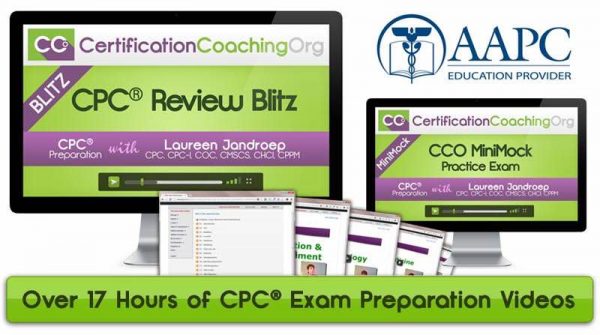

This is GREAT! I will use it as I get closer to taking the
National Exam!
Wow! Amazing tips! Thank you!
I think that’s what hurt me the first two attempts I can’t seem to leave the billing side out because I do it every day
Great advice. I think this would help me to be able to take the exam with confidence to answer all the questions correctly. Amazing tips indeed!
Being a medical biller does hinder students with the test. You know the encounters with insurance carriers or the tricks we have learned to be successful with claim payments. The hardest thing for me to do was unwrap the biller part of my brain as if it did not exist. Until realizing this, I kept struggling and missing questions.
Very good points Tammy!
Great tips! I will be taking the CPC exam next month and I need all the advice I can get. Thanks!
Best wishes Tierra! Don’t forget to do TIMED practice exams – they really help you with that final prep!
Very true! You want to take this exam one time (once) and be done with it! I had to learn the hard way and unfortunately it cost me time, money and lots of retakes to pass this exam. I passed the exam because I used Laureen’s technique. I wished I knew before I sat for my first exam. It took a lot of heartache, wasted time and bad choices to finally help me realize this was it. Laureen’s video was the missing puzzle in my picture.
Thanks Angie! Share your story on the official BHAT™ page and perhaps you’ll win a mug or tote! https://www.cco.us/bhat/
Hi Lauren!I will be taking the CPC exam in a about 3 months and I need to have a comprehensive review since this is my first time and to be honest,I’m nervous..I hope you can help to pass this exam.Thank you in advance!
Hi
Im in the process of taking the exam and I have been done with courses since 2016. I would like help with coding my books, with tabs any help I can get to pass the exam
The BHAT® Method teaches you how to markup your manuals. You can get it by purchasing any Course, Review Blitz or by joining the CCO Club at https://www.cco.us/club/
We also have a CCO Proven Process for passing any AAPC exam at https://www.cco.us/cco-proven-process/
Good luck on your exam!